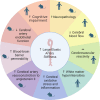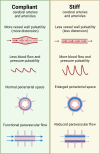Impact of arterial stiffness on cerebrovascular function: a review of evidence from humans and preclincal models
- PMID: 38214904
- PMCID: PMC11221809
- DOI: 10.1152/ajpheart.00592.2023
Impact of arterial stiffness on cerebrovascular function: a review of evidence from humans and preclincal models
Abstract
With advancing age, the cerebral vasculature becomes dysfunctional, and this dysfunction is associated with cognitive decline. However, the initiating cause of these age-related cerebrovascular impairments remains incompletely understood. A characteristic feature of the aging vasculature is the increase in stiffness of the large elastic arteries. This increase in arterial stiffness is associated with elevated pulse pressure and blood flow pulsatility in the cerebral vasculature. Evidence from both humans and rodents supports that increases in large elastic artery stiffness are associated with cerebrovascular impairments. These impacts on cerebrovascular function are wide-ranging and include reductions in global and regional cerebral blood flow, cerebral small vessel disease, endothelial cell dysfunction, and impaired perivascular clearance. Furthermore, recent findings suggest that the relationship between arterial stiffness and cerebrovascular function may be influenced by genetics, specifically APOE and NOTCH genotypes. Given the strength of the evidence that age-related increases in arterial stiffness have deleterious impacts on the brain, interventions that target arterial stiffness are needed. The purpose of this review is to summarize the evidence from human and rodent studies, supporting the role of increased arterial stiffness in age-related cerebrovascular impairments.
Keywords: aging; arterial stiffness; blood pressure; cerebral blood flow; cerebrovascular.
Conflict of interest statement
No conflicts of interest, financial or otherwise, are declared by the authors.
Figures






References
-
- Walker AE, Cullen AE, Fico BG, Barnes JN. Cerebrovascular function in aging. In: Cardiovascular Neuroendocrinology. Masterclass in Neuroendocrinology, edited by Yosten GLC, Cunningham JT.. Cham: Springer International Publishing, 2023, vol. 14, p. 137–171.
Publication types
MeSH terms
Grants and funding
- RF1 NS117746/NS/NINDS NIH HHS/United States
- R03 AG070469/AG/NIA NIH HHS/United States
- TL1 TR002371/TR/NCATS NIH HHS/United States
- AG070469/HHS | NIH | National Institute on Aging (NIA)
- R56 AG064016/AG/NIA NIH HHS/United States
- R01 AG064016/AG/NIA NIH HHS/United States
- AG064016/HHS | NIH | National Institute on Aging (NIA)
- R01 NS117746/NS/NINDS NIH HHS/United States
- AARG-20-675709/Alzheimer's Association (AA)
- TL1TR002371/HHS | NIH | National Center for Advancing Translational Sciences (NCATS)
- NS117746/HHS | NIH | National Institute of Neurological Disorders and Stroke (NINDS)
LinkOut - more resources
Full Text Sources
Miscellaneous

